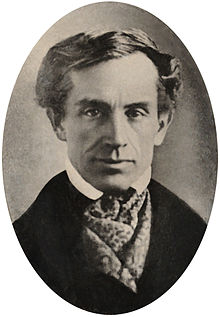Samuel Finley Breese Morse
| Samuel Morse | |
|---|---|

Samuel Finley Breese Morse, 1840
|
|
| Born |
Samuel Finley Breese Morse April 27, 1791 Charlestown, Massachusetts |
| Died | April 2, 1872 (aged 80) 5 West 22nd Street, New York City, New York |
| Education | Yale College |
| Occupation | Painter, inventor |
| Known for | The invention and transmission of Morse code |
| Spouse(s) |
|
| Signature | |
Samuel Finley Breese Morse (April 27, 1791 – April 2, 1872) was an American painter and inventor. After having established his reputation as a portrait painter, in his middle age Morse contributed to the invention of a single-wire telegraph system based on European telegraphs. He was a co-developer of the Morse code and helped to develop the commercial use of telegraphy.
Samuel F. B. Morse was born in Charlestown, Massachusetts, the first child of the pastor Jedidiah Morse (1761–1826), who was also a geographer, and his wife Elizabeth Ann Finley Breese (1766–1828). His father was a great preacher of the Calvinist faith and supporter of the American Federalist party. He thought it helped preserve Puritan traditions (strict observance of Sabbath, among other things), and believed in the Federalist support of an alliance with Britain and a strong central government. Morse strongly believed in education within a Federalist framework, alongside the instillation of Calvinist virtues, morals, and prayers for his first son.
After attending Phillips Academy in Andover, Massachusetts, Samuel Morse went on to Yale College to receive instruction in the subjects of religious philosophy, mathematics, and science of horses. While at Yale, he attended lectures on electricity from Benjamin Silliman and Jeremiah Day and was a member of the Society of Brothers in Unity. He supported himself by painting. In 1810, he graduated from Yale with Phi Beta Kappa honors.
...
Wikipedia
